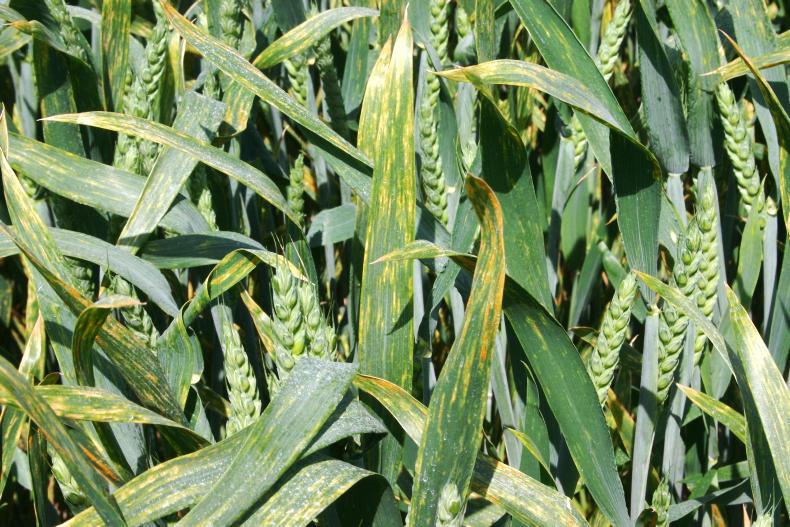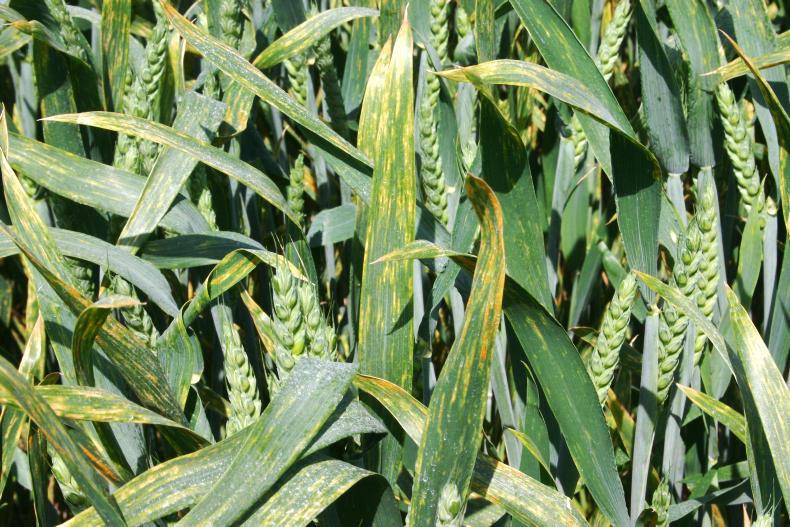If you are one of these growers who seldom has to tackle any of the rust diseases, then it is important to state that these are serious diseases. Growers may be somewhat used to dealing with crown rust on oats, as most of our varieties are very susceptible. Many wheat growers are less familiar with yellow rust and this an even more serious disease.
Yellow rust infection is now evident around the country. Like all the rust diseases the fungus grows in the leaf tissue and the multiplicity of spores produced erupt through the leaf surface to spread the disease locally. For this reason it is generally found, initially, in small circles but if you do not stop a small circle it will become a big circle very quickly.
An active disease lesion continues to spew out spores for distribution and total defoliation of infected patches can occur very quickly. However, while spores mainly move locally, they can be carried in the wind and indeed it is common that the initial appearance of new races that can attack previously resistant varieties will arrive into north Leinster on an easterly wind. Sometimes spores can be carried further west and even up into Donegal. Then, as in 2017, a northerly wind distributes the infection southwards.
Yellow rust has been very evident in winter wheat crops in north Leinster all winter and especially in springtime. The young disease on young plants tends to produce individual brown lesions which produce millions of spores for distribution. As the leaf becomes stronger and older the disease symptoms change and new lesions appear as elongated lesions between veins and the spore colour is definitely yellow. The lesion shape gives it its other name, which is stripe rust.
An untreated outbreak can severely defoliate a susceptible variety within a few weeks. For this reason it can be a severe yield robber with up to 60% yield loss commonly recorded in this country. So it is certainly not a disease to ignore.
Treatment
The challenge with yellow rust is to identify it early. In theory, all modern fungicides are effective against yellow rust but efficacy will be influenced by the specific actives applied and timing of application relative to infection. Like all other diseases, yellow rust has a lag period between initial infection and the appearance of lesions so one can spray a crop not having seen infection to find it a number of days later because the disease had broken out before the fungicide actives could stop it.
There are differences in the ability of actives to halt yellow rust. There has been no evidence of reduced sensitivity of fungicides to rusts but individual actives do have different capabilities on the disease. Triazoles such as epoxiconazole (Opus/Strand) and tebuconazole (Folicur) have always been strong against the disease. They tend to be able to dry up an existing infection and provide further protection but, as with other diseases, they cannot make the lesion go away.
Traditionally, a raging infection is best addressed through the application of a morpholine. These tend to provide the fastest knockdown but they are not the most persistent. Epoxiconazole and tebuconazole have always given good control but this can only begin from the point of application. In general, strobilurin and SDHI actives function as good preventatives or protectants and so work against future infection more so that a current infection.
Activity
Research compiled by AHDB in the UK suggests difference in product capability on yellow versus brown rust. Of the products tested, epoxiconazole was more effective than prothioconazole and the same holds for mixtures with other families. A summary point that says that SDHI/azole mixtures are more robust than solo SDHI actives in terms of yield response and yellow rust control should be considered in the light of T2 decisions now.
In this regard, mixes containing metconazole or prothioconazole will be weaker against yellow rust especially where infection is visible and vibrant. So if you are using products like Librax or Elatus or Ascra you should include a morpholine (0.7 l/ha) to get a quick knockdown of existing infection. If you are using products based on epoxiconazole (Adexar) you may need to add additional epoxiconazole if you are using a reduced rate of the mix. This disease needs to be stopped.
Knowing when active disease has been controlled is not so easy, as new infection can always take place if not prevented. Yellow spores may still be present in lesions even after it is controlled and the lesion will continue to exist. Healthy lesions will continue to spew out spores so a gentle rub of your finger or a white tissue will give an indication of the level of spores being produced. If you only get a few spores and little discolouration then the disease has obviously been hit. But keep a continuous eye on your crops especially for the appearance of new lesions.














SHARING OPTIONS